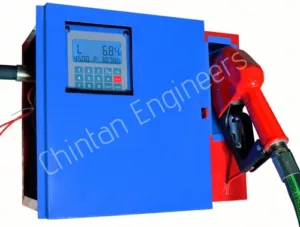



Fuel Dispenser Machines for Industrial & Commercial Fueling
Chintan Engineers builds configurable fuel dispensing systems for diesel, petrol, kerosene, and specialty fluids. Choose compact trolley kits for mobile bowsers or stationary dispensers with smart controls, preset batching, printer integration, and flameproof safety. Every unit ships ready to install with metering, filtration, hose management, and nationwide service support.
Talk to an engineer: Request a customised proposal.
Quick Specs
- Flow range: 20 – 110 L/min depending on model
- Accuracy: ±0.5 % standard; high-precision builds (CE-204) achieve ±0.2 %
- Power options: 12 / 24 V DC for mobile kits, 220 V single-phase or 440 V three-phase AC for stationary units
- Compatible fuels: Diesel, petrol, kerosene, biodiesel, custom liquids (CE-215)
- Control stack: Mechanical and digital PDP meters, preset batching, optional receipt printer, pulse output for automation
- Service: Site assessment, installation, calibration certificate, annual maintenance contracts, pan-India spares support
Model Comparison
| Model | Flow Range* | Meter Type | Power Options | Highlight Features | Ideal Applications |
| — | — | — | — | — | — |
| CE-202 Digital Dispenser | 20 – 60 L/min | Digital PDP | 12 / 24 V DC or 220 V AC | Compact, electronic display, auto shut-off nozzle | Fleet yards, mobile refuelling, workshops |
| CE-204 High Accuracy Dispenser | 20 – 80 L/min | Digital preset controller | 12 / 24 V DC, 220 V AC | ±0.2 % accuracy, volume/amount preset, receipt printer, 365-day log | Fuel depots needing audit-ready records |
| CE-215 Custom Liquid Dispenser | Customisable | Digital | 12 / 24 V DC, 220 V AC | Engineered for varied viscosities, ±0.2 % fixed dosing, tailored manifolds | Chemical, lube, and specialty fluid transfer |
| CE-217 Heavy-Duty Fuel Dispenser | Up to 110 L/min | Oval gear | 440 V AC (3Φ) | 1.2 kW rotary vane pump, high throughput, 1.5\" connections | High-volume depots, loading bays |
| CE-130 Mobile Preset Dispenser | 20 – 60 L/min | Digital preset | 12 / 24 V DC, 220 V AC | Vehicle/trolley mount, preset batching, optional telemetry | Remote projects, tanker-mounted fueling |
<small>* Confirm flow rate, accuracy, and accessory requirements during the quotation phase; custom builds available.</small>
Why Operations Teams Rely on Chintan Engineers
- Metering accuracy with accountability: Positive displacement meters with preset controllers deliver ±0.5 % accuracy or ±0.2 % on CE-204, with printable receipts and 365-day data logs for reconciliation.
- Flexible deployment: DC-powered mobile kits, stationery pedestal units, and skid/trolley mounts cover workshop, depot, and field fueling scenarios.
- Multi-fuel capability: Materials and seals selected for diesel, petrol, kerosene, biodiesel, and customised fluids (CE-215).
- Built for Indian conditions: Weather-sealed enclosures, industrial rotary vane pumps, and locally stocked spares minimize downtime.
- Safety & compliance: Auto shut-off nozzles, grounding guidance, optional flameproof motors, and calibration certificates align with Legal Metrology expectations.
- Integration ready: Pulse outputs, optional telemetry (CE-216 Remote Monitoring Solution), and printer integration connect dispensers to ERP or fleet management systems.
Where These Dispensers Excel
- Fleet and logistics hubs requiring controlled fueling to reduce shrinkage
- Construction, mining, and infrastructure projects that need mobile bowser fueling
- Agriculture & rental equipment yards servicing tractors, loaders, and gensets
- Industrial depots dispensing multiple fuel grades or lubricants
- Petrol pump forecourts and private stations needing metered delivery
Installation & Commissioning Support
- Site survey: Evaluate tank layout, electrical supply, and safety clearances; recommend filtration and hose management.
- Foundation & mounting: Prepare concrete base or skid, install dispenser, hose trays, and protective bollards as required.
- Connections & safety: Plumb suction/delivery lines, install isolation valves, wire power and grounding, and pressure-test for leaks.
- Calibration & documentation: Perform volume proving, issue calibration certificate, and set presets/pricing as required.
- Training & AMC: Train operators on safe dispensing, logging, and maintenance; offer annual maintenance with rapid spares turnaround.
Accessories & Upgrades
- Hose reels (3 – 6 m) with anti-static hose assemblies
- Auto shut-off nozzles, swivels, strainers, water separators
- Receipt printers, barcode/RFID readers, pulse output modules
- Remote monitoring, GPS telemetry, and fuel accounting dashboards
- Flameproof (Ex) motors and enclosures for hazardous zones
Selecting the Right System
- Fuel grade & volume: Match flow range and materials to the product and daily throughput.
- Installation type: Decide between fixed pedestal, skid-mounted, or vehicle-mounted deployment.
- Control needs: Choose mechanical meters for simplicity or digital preset/receipt systems for auditing.
- Power availability: Use DC for on-vehicle or remote sites; leverage single/three-phase AC for depot installs.
- Regulatory environment: Specify flameproof motor, metrology seals, and calibration intervals based on site compliance requirements.
Frequently Asked Questions
Which fuels can these dispensers handle?
Standard builds cover diesel, petrol, kerosene, and biodiesel; CE-215 is engineered for custom fluids—share MSDS for confirmation.
Can we record each fueling transaction?
Yes. Digital models support receipt printing, pulse outputs, and integration with telemetry or ERP for automated logging.
Do you supply tanker-mounted kits?
CE-130 and CE-202 DC variants include mounting hardware for bowsers and service trucks, complete with hose reels and preset controls.
Do you provide installation and calibration?
Chintan Engineers offers turnkey installation, calibration certificates, operator training, and annual maintenance across India.
Can we add flameproof protection?
Yes. Specify EX/FLP motors, enclosures, and accessories for hazardous-area compliance (e.g., petrochemical or refinery sites).
Ready to Upgrade Your Fuel Dispensing?
Request a customised fuel dispenser proposal and an engineer will share configuration options, lead time, and documentation.
